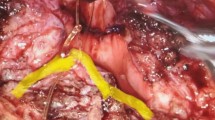Abstract
Background
Prostate cancer in men raises many of the same issues that breast cancer does in women. Complications of prostate cancer treatment, including impotence and incontinence, affect the self-image and psyche of a man no less than does the loss of a breast in a woman. We present a pilot study in which 21 patients were treated with a focal cryoablation procedure.
Methods
Focal cryoablation was performed using biplane transrectal ultrasound if the tumor was confined to only one prostate lobe. Preoperative PSA values were recorded. Cryoablation was planned to encompass the area of known tumor. PSA values were obtained every 3 months for 2 years and every 6 months thereafter. Potency and continence status was obtained at the same intervals. Routine biopsy was obtained at 1 year.
Results
Twenty-one patients had focal cryoablation. Follow-up ranged from 24 to 105 months with a mean of 50 months. Twenty of 21 (95%) patients have stable PSA values with no evidence for cancer, despite 10 patients being at medium to high risk for recurrence. All patients biopsied (n = 19) were negative for tumor. Potency was maintained in 17 of 21 patients (80%). No other complications, including incontinence or fistula formation, were noted.
Conclusion
These preliminary results indicate a “male lumpectomy,” in which the prostate tumor region itself is destroyed, appears to preserve potency in a majority of patients and limits other complications, without compromising cancer control. If these results are confirmed by further studies and long-term follow-up, this treatment approach could have a profound effect on prostate cancer management.
Similar content being viewed by others
References
Messing EM, Thompson I (2003) Follow-up of conservatively managed prostate cancer: Watchful waiting and primary hormonal therapy. Urol Clin North Am 30:687–702
Catalona WJ, Basler JW (1993) Return of erections and urinary continence following nerve sparing radical retropubic prostatectomy. J Urol 150:905–907
Sanchez-Ortiz RF, Broderick GA, Rovner ES, et al. (2000) Erectile function and quality of life after interstitial radiation therapy for prostate cancer. Int J Impot Res 12 (Suppl 3):S18–S24
Talcott JA, Reiker P, Propert KJ, et al. (1989) Patient reported impotence and incontinence after nerve-sparing radical prostatectomy. J Natl Cancer Inst 16:1117–1123
Zelefsky MJ, Hollister T, Raben, et al. (2000) Five year biochemical outcome and toxicity with transperineal CT-planned permanent I-125 prostate implantation for patients with localized prostate cancer. Int J Radiat Oncol Biol Phys 47:1261–1266
Bagley GP (1999) Cryosurgical ablation of the prostate. Decision memorandum 2/01/99. Issue #CAG-00031
Bahn DK, Lee F, Bandalament R, et al. (2002) Seven-year outcomes in the primary treatment of prostate cancer. Urology 60(Suppl 1):3–11
Donnelly BJ, Salikan JC, Ernst DS, et al. (2002) Prospective trial of cryosurgical ablation of the prostate: Five year results. Urology 60:645
Djavan B, Susani M, Bursa B, et al. (1999) Predictability and significance of multi-focal prostate cancer in the radical prostatectomy specimen. Techn Urol 5:139–142
Villers A, McNeal JE, Freiha FS, et al. (1992) Multiple cancers in the prostate: Morphologic features of clinically recognized vs. incidental tumors. Cancer 70:2312–2318
Rukstalis DB, Goldknopf JL, Crowley EM, et al. (2002) Prostate cryoablation: A scientific rationale for future modifications. Urology 60:19–25
Noguchi M, Stamey TA, McNeal JE et al. (2003) Prognostic factors for multifocal prostate cancer in radical prostatectomy specimens: Lack of significance of secondary cancers. J Urol 170:459–463
Onik G, Narayan P, Vaughan D, et al. (2002) Focal nerve sparing cryoablation for the treatment of primary prostate cancer: A new approach to preserving potency. Urology 60:109–114
Onik GM, Cohen JK, Reyes GD, et al. (1993) Transrectal ultrasound-guided percutaneous radical cryosurgical ablation of the prostate. Cancer 72:1291–1299
Santiago RJ, Wu L, Harris E, Fox K, Schultz D, Glick J, Solin LJ (2004) Fifteen-year results of breast-conserving surgery and definitive irradiation for Stage I and II breast carcinoma: The University of Pennsylvania experience. Int J Radiat Oncol Biol Phys 58:233–240
Brassel SA, Rosner IL, Mcleod DG (2005) Update on magnetic resonance imaging, Prstascint and novel imaging in prostate cancer. Curr Opin Urol 15:233–240
Levine MA, Ittman M, Melamed J (1998) Two consecutive sets of transrectal ultrasound guided sextant biopsies of the prostate for the detection of prostate cancer. J Urol 159:471–475
Graefen M, Hammerer P, Michl U, et al. (1998) Incidence of positive surgical margins after biopsy-selected nerve sparing radical prostatectomy. Urology 51:437–442
Onik GM (2004) 3D global mapping biopsies: A more efficacious method of determining the extent of prostate cancer. Presented at Society of Uroradiology annual meeting, Scottsdale, AZ, March 7, 2004
Katz A, Rewcastle JC (2003) The current and potential role of cryoablation as a primary treatment for prostate cancer. Curr Oncol Rep 5:231–238
Gould RS (1999) Total cryoablation of the prostate versus standard cryoablation versus radical prostatectomy: Comparison of early results and the role of trans-urethral resection in cryoablation. J Urol 162:1653–1657
O’Sullivan DC, Barrett DM, Colby TV, et al. (1992) Effect of external beam radiation therapy on prostatic carcinoma DNA content as measured by static image cytometry. Eur Urol 21:235–239
Zlotta AR, Djavan B, Matos C, et al. (1998) Percutaneous transperineal radiofrequency ablation of the prostate tumour: Safety, feasibility, and pathological effects on human prostate. Br J Urol 81:265–275
Chen JC, Moriarty JA, Derbyshire JA (2000) Prostate cancer: MR imaging and thermometry during microwave thermal ablation-initial experience. Radiology 214(1):290–297
Boni RA, Sulser T, Jochum W (1997) Laser ablation indices changes in the prostate: Findings at endorectal imaging with histologic correlation. Radiology 202:232–236
Uchida T (2005) High intensity focused ultrasound for localized prostate cancer. Nippon Rinsho 63:345–349
Author information
Authors and Affiliations
Corresponding author
Rights and permissions
About this article
Cite this article
Onik, G. Rationale for a “Male Lumpectomy,” a Prostate Cancer Targeted Approach Using Cryoablation: Results in 21 Patients with at Least 2 Years of Follow-Up. Cardiovasc Intervent Radiol 31, 98–106 (2008). https://doi.org/10.1007/s00270-004-0232-0
Published:
Issue Date:
DOI: https://doi.org/10.1007/s00270-004-0232-0




